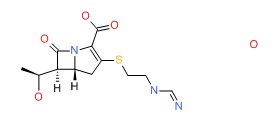NCBI Bookshelf. A service of the National Library of Medicine, National Institutes of Health.
LiverTox: Clinical and Research Information on Drug-Induced Liver Injury [Internet]. Bethesda (MD): National Institute of Diabetes and Digestive and Kidney Diseases; 2012-.

LiverTox: Clinical and Research Information on Drug-Induced Liver Injury [Internet].
Show detailsOVERVIEW
Imipenem is a broad spectrum carbapenem antibiotic which is used for severe bacterial infections caused by susceptible organisms. Because imipenem is rapidly inactivated by renal dehydropeptidase I (DHP-1), it is given in combination with cilastatin, a DHP-I inhibitor which increases half-life and tissue penetration of imipenem. Parenterally administered imipenem/cilastatin has been associated with transient, mild serum aminotransferase elevations, but it is a rare cause of clinically apparent liver disease with jaundice.
Background
Imipenem (im" i pen' em) is a broad spectrum beta-lactam antibiotic which is used for severe bacterial infections caused by susceptible organisms. Because imipenem is rapidly inactivated by renal dehydropeptidase I (DHP-1), it is given in combination with cilastatin (sye" la stat' in), a DHP-I inhibitor which increases half-life and tissue penetration of imipenem. Imipenem-cilastatin, like other carbapenems, binds to bacterial penicillin binding proteins and interferes with bacterial cell wall integrity and synthesis. It is a broad spectrum antibiotic with activity against many aerobic and anaerobic gram-positive and gram-negative organisms, including Staphylococcus aureus, Streptococcus pyogenes, Streptococcus agalactiae, viridans group streptococci, Enterococcus faecalis, Pseudomonas aeruginosa, Escherichia coli, Proteus mirabilis, Bacteroides fragilis and Peptostreptococcus species. Imipenem/cilastatin was approved for use in the United States in 1985. Imipenem-cilastatin is indicated for the treatment of severe or complicated skin, tissue, joint, respiratory tract, intraabdominal, urinary tract and urogenital infections as well as meningitis, endocarditis and sepsis due to susceptible organisms. Its use is generally restricted to severe infections largely in hospitalized patients. The recommended dosage is 250 mg to 1 gram given intravenously every 6 to 8 hours or in intramuscular doses of no more than 1.5 g daily, usually for 5 to 14 days. The combination of imipenem and cilastatin is available generically and under the brand name Primaxin as 250 mg or 500 mg infusion bottles for IV use or 500 mg or 750 mg vials of lyophilized powder for im injection. The most common side effects of imipenem are diarrhea, nausea, vomiting, skin rash, pruritus and injection site reactions.
Hepatotoxicity
In large clinical trials, imipenem was associated with transient and asymptomatic elevations in serum aminotransferase levels in approximately 6% of patients given the drug for 5 to 14 days. More serious hepatic injury from imipenem/cilastatin is rare, but jaundice and liver test abnormalities have been reported in 0.1% of patients in prospective trials of the agent. Several instances of cholestatic jaundice arising during or shortly after therapy have been reported with imipenem-cilastatin and other carbapenems. The latency to onset has been within 1 to 3 weeks and the pattern of enzyme elevations is usually cholestatic. Immunoallergic features can occur, but autoantibodies are rare. The course is usually self-limiting, but at least one case of vanishing bile duct syndrome related to the carbapenems has been reported. Imipenem and other carbapenems have not been linked to cases of acute liver failure in the published literature, but the product label for imipenem mentions that instances of jaundice and severe liver injury attributed to imipenem have been reported to the sponsor.
Likelihood score: D (possible rare cause of clinically apparent liver injury).
Mechanism of Liver Injury
The cause of the mild, transient serum enzyme elevations during imipenem-cilastatin therapy is not known. The cholestatic hepatitis attributed to imipenem-cilastin and the carbapenems is probably immunoallergic and resembles the rare clinically apparent liver injury that has been linked to penicillins and cephalosporins.
Outcome and Management
The liver injury due to the carbapenems is usually mild and self-limited. Rarely, the carbapenems can cause a clinically apparent acute cholestatic hepatitis that is usually self-limiting and not requiring therapy or intervention. In patients with vanishing bile duct syndrome, corticosteroids are often used but have not been shown to be beneficial and are best avoided. Some patients may benefit from symptomatic therapy of the pruritus associated with cholestasis using antihistamines, ursodiol or cholestyramine. There is little information on possible cross sensitivity to liver injury among the different beta-lactam antibiotics, but patients with clinically apparent liver injury due to imipenem should probably avoid the other carbapenems.
References to the safety and potential hepatotoxicity of imipenem are given in the Overview section on Carbapenems.
Drug Class: Antiinfective Agents, Carbapenems
Other Drugs in the Subclass, Carbapenems: Doripenem, Ertapenem, Meropenem
PRODUCT INFORMATION
REPRESENTATIVE TRADE NAMES
Imipenem – Generic, Primaxin®
DRUG CLASS
AntiInfective Agents
Product labeling at DailyMed, National Library of Medicine, NIH
CHEMICAL FORMULA AND STRUCTURE
| DRUG | CAS REGISTRY NO | MOLECULAR FORMULA | STRUCTURE |
|---|---|---|---|
| Imipenem | 74431-23-5 | C12-H17-N3-O4-S.H2O |
 |
- PubChem SubstanceRelated PubChem Substances
- Review Carbapenems.[LiverTox: Clinical and Researc...]Review Carbapenems.. LiverTox: Clinical and Research Information on Drug-Induced Liver Injury. 2012
- Review Sulopenem: An Intravenous and Oral Penem for the Treatment of Urinary Tract Infections Due to Multidrug-Resistant Bacteria.[Drugs. 2022]Review Sulopenem: An Intravenous and Oral Penem for the Treatment of Urinary Tract Infections Due to Multidrug-Resistant Bacteria.Zhanel GG, Pozdirca M, Golden AR, Lawrence CK, Zelenitsky S, Berry L, Schweizer F, Bay D, Adam H, Zhanel MA, et al. Drugs. 2022 Apr; 82(5):533-557. Epub 2022 Mar 16.
- Review Comparative review of the carbapenems.[Drugs. 2007]Review Comparative review of the carbapenems.Zhanel GG, Wiebe R, Dilay L, Thomson K, Rubinstein E, Hoban DJ, Noreddin AM, Karlowsky JA. Drugs. 2007; 67(7):1027-52.
- Review Imipenem/cilastatin: the first carbapenem antibiotic.[Drug Intell Clin Pharm. 1985]Review Imipenem/cilastatin: the first carbapenem antibiotic.Lyon JA. Drug Intell Clin Pharm. 1985 Dec; 19(12):895-9.
- Imipenem/cilastatin/relebactam: A new carbapenem β-lactamase inhibitor combination.[Am J Health Syst Pharm. 2021]Imipenem/cilastatin/relebactam: A new carbapenem β-lactamase inhibitor combination.Mansour H, Ouweini AEL, Chahine EB, Karaoui LR. Am J Health Syst Pharm. 2021 Mar 31; 78(8):674-683.
- Imipenem-Cilastatin - LiverToxImipenem-Cilastatin - LiverTox
Your browsing activity is empty.
Activity recording is turned off.
See more...